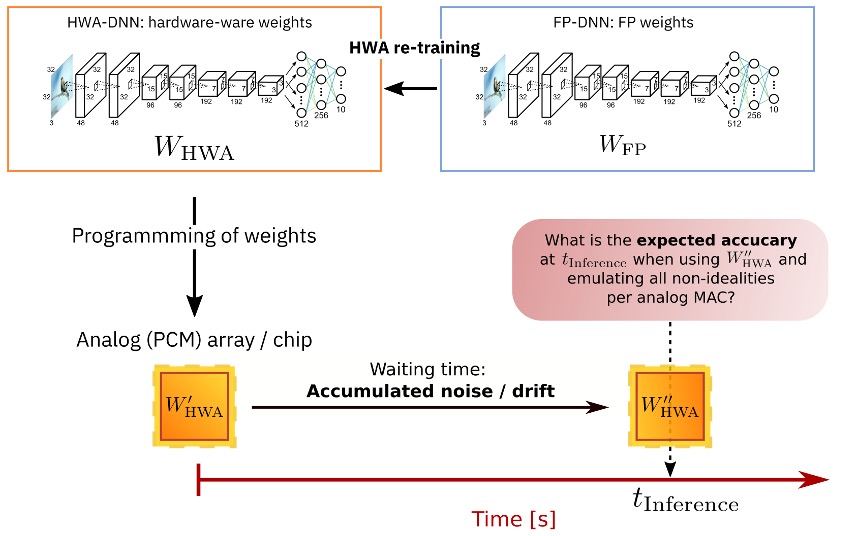Analog Hardware-aware Training
Introduction
When performing inference on Analog hardware, direct transfer of the weights trained on a digital chip to analog hardware would results in reduced network accuracies due to non-idealities of the non-volatile memory technologies used in the analog chip. For example, a common non-ideality of Phase Change Memory is the resistance drift. This drift is due to structural relaxation of the physical material composing the memory and causes an evolution of the memory resistance over time, which translates in a change in the weight stored in the memory array. This would eventually result in a decrease network accuracy over time. What one can do is to train the network on digital accelerator but in a way that is aware of the hardware characteristics that will be used in the inference pass, we refer to this as Hardware Aware Training (HWA).

Hardware-aware re-training greatly improves analog inference accuracy [2]. This technique was also shown to be effective for digital hardware. For example in the case of quantization-aware training. For Analog inference, the the network could be prepared or pretrained in digital with the usual deep learning training methods. The fully trained network is then programmed on the analog chip to accelerate inference. Due to the noisiness of the programming and the drifting of the conductance values over time for some of the materials, we need to evaluate the accuracy of the model for different time points after programming the weights on the analog chip.
The figure below shows how the noise can be added during the training in the forward pass:

InferenceRPUConfig
The example below shows how you can define an analog tile configuration with options for hardware-aware training.:
from aihwkit.simulator.configs import InferenceRPUConfig
# Define the inference/hardware-aware training tile
rpu_config = InferenceRPUConfig()
# Define the analog model, e.g., by converting a given floating point (FP) model
from torchvision.models import resnet34 # e.g., trained model from torch
analog_model = convert_to_analog(resnet34(), rpu_config, weight_scaling_omega=1.0)
# [... do hardware-aware (re)-training ...]
# Evaluate the model after programming the weights and driting over a certain period of time
analog_model = AnalogSequential(analog_model).eval()
t_inference = 1000 #desired time of drift in seconds after programming
analog_model.drift_analog_weights(t_inference)
# [... evaluate programmed drifted model ...]
Example of hardware-aware training with PCM noise model
The PCM noise model (see section Inference and PCM Statistical Model) can be used in our package
in the following way. Instead of using a regular analog tile, that is catered
to doing training on analog with pulsed update and others (see Section
Using Analog Tiles), you can use an _inference_ tile that
only has non-idealities in the forward pass, but a perfect update and
backward pass. Moreover, for inference, weights can be subject to
realistic weight noise and drift as described above. To enable this
inference features, one has to build an model using our
InferenceTile (see also
example 5):
from aihwkit.simulator.configs import InferenceRPUConfig
from aihwkit.simulator.configs.utils import WeightNoiseType
from aihwkit.inference import PCMLikeNoiseModel, GlobalDriftCompensation
# Define a single-layer network, using inference/hardware-aware training tile
rpu_config = InferenceRPUConfig()
# specify additional options of the non-idealities in forward to your liking
rpu_config.forward.inp_res = 1/64. # 6-bit DAC discretization.
rpu_config.forward.out_res = 1/256. # 8-bit ADC discretization.
rpu_config.forward.w_noise_type = WeightNoiseType.ADDITIVE_CONSTANT
rpu_config.forward.w_noise = 0.02 # Some short-term w-noise.
rpu_config.forward.out_noise = 0.02 # Some output noise.
# specify the noise model to be used for inference only
rpu_config.noise_model = PCMLikeNoiseModel(g_max=25.0) # the model described
# specify the drift compensation
rpu_config.drift_compensation = GlobalDriftCompensation()
# build the model (here just one simple linear layer)
model = AnalogLinear(4, 2, rpu_config=rpu_config)
Once the DNN is trained (automatically using hardware-aware training, if the forward pass has some non-idealities and noise included), then the inference with drift and drift compensation is done in the following manner:
model.eval() # model needs to be in inference mode
t_inference = 3600. # time of inference in seconds (after programming)
program_analog_weights(model) # can also omitted as it is called below in any case
drift_analog_weights(model, t_inference) # modifies weights according to noise model
# now the model can be evaluated with programmed/drifted/compensated weights
Note that we here have two types of non-linearities included. For the first, longer-term weight noise and drift (as described above), we assume that during the evaluation the weight related PCM noise and the drift is done once and then weights are kept constant. Thus, a subsequent test error calculation over the full test set would signify the expected test error for the model at a given time. Ideally, one would want to repeat this for different weight noise and drift instance and or different inference times to access the accuracy degradation properly.
The second type of non-idealities are short-term and on the level of
a single analog MACC (Multiply and Accumulate). Noise on that level vary
with each usage of the analog tile and are specified in the
rpu_config.forward.
For details on the implementation of our inference noise model, please
consult PCMLikeNoiseModel. In
particular, we use a
SinglePairConductanceConverter
to convert weights into conductance paris and then apply the noise pn
both of these pairs. More elaborate mapping schemes can be
incorporated by extending
BaseConductanceConverter.